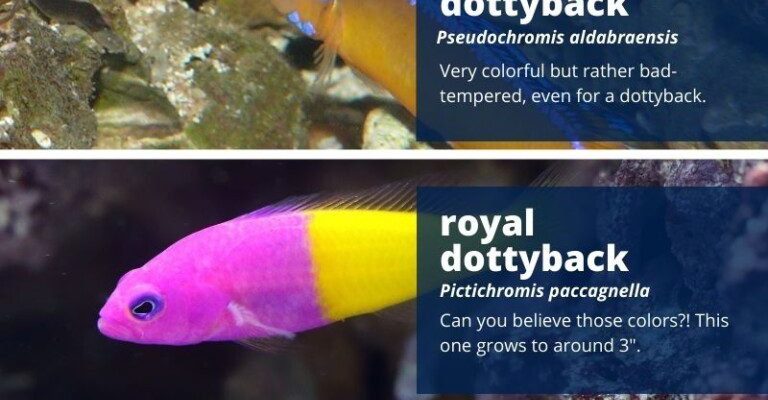
Let’s treat this as a casual coffee chat. Picture us sitting down with a warm cup, diving into the nitty-gritty of dottyback health. By the end of our conversation, you’ll have a clear picture of common problems these fish face and how to keep them swimming happily.
Understanding Dottyback Health Issues
Dottybacks, known for their vibrant colors and feisty nature, can encounter a range of health problems. Understanding these issues is the first step in preventive care. Their health largely depends on proper tank conditions and diet, just like how our well-being is affected by our environment and what we eat.
Common health problems in dottybacks can include things like ich, fin rot, and even stress-related issues. These concerns can often be traced back to their tank conditions or what they’re being fed. Think of it like this: if your living environment is cluttered and you’re not eating well, you might feel under the weather too!
So, how do we prevent these issues? First off, let’s dig deeper into the specific problems dottybacks face.
Ich: The Common Parasite
Ich, or *Ichthyophthirius multifiliis*, is a pesky parasite that can affect dottybacks. If you notice your fish rubbing against objects or developing white spots, you might be dealing with ich. This little critter can be devastating if left unchecked. So, what can you do to tackle it?
Prevention starts with tank conditions. Keeping your water clean and stable is crucial, as stress from poor water quality can lead to outbreaks. Regularly testing your water for ammonia, nitrites, and nitrates will help ensure everything is in line.
When it comes to treating ich, consider a quarantine tank. This allows you to isolate the infected dottyback without risking the entire tank. You can use treatments like copper-based medications in this separate tank, resetting the environment for the healthy fish.
Fin Rot: A Sign of Poor Water Quality
Fin rot is another issue that many dottyback owners might encounter. This bacterial infection can happen if the water quality in their tank isn’t up to par. If you see ragged or frayed fins, it could be a sign that your fish is struggling.
Let’s break this down a bit. Fin rot often stems from stress, which is usually caused by poor water quality or overcrowding. To prevent this, make sure you have a proper filtration system in place and keep up with regular tank maintenance.
Tools like water conditioners can help maintain a safe environment. If you spot fin rot early, a simple treatment with aquarium antibiotics might do the trick. The key is to act fast and create a healthy habitat for your fish.
Stress: The Silent Health Issue
Stress is perhaps the most insidious health problem for dottybacks. It can show its ugly head in various ways, from reduced appetite to aggression. But what causes stress in these little fish?
There are several factors to consider. Overcrowding, sudden changes in water temperature, or even aggressive tank mates can lead to a stressed-out dottyback. Imagine cramming too many people into a small room—it gets uncomfortable fast!
To keep stress levels in check, ensure your tank is appropriately sized and that your dottyback has plenty of hiding spaces. Using decorations and plants can help them feel secure. Also, keeping an eye on tank mates ensures a harmonious environment.
Nutritional Needs: Feed Them Right
What you feed your dottyback can significantly impact their health. A poor diet can lead to malnourishment and related health problems. Dottybacks are carnivorous, so they require a diet rich in protein.
Feeding them a mix of high-quality flakes, frozen foods, and live options like brine shrimp can help keep them in tip-top shape. It’s a bit like preparing a well-balanced meal for yourself—variety is the spice of life!
Monitor their feeding habits, too. If you notice that your dottyback is losing weight or seems lethargic, it might be time to evaluate their diet. A diverse menu can make all the difference in keeping them healthy and vibrant.
Regular Water Testing: The Basics of Tank Maintenance
Think of water quality testing as your dottyback’s “health check-up.” Regularly testing the water ensures that any harmful substances don’t creep in unnoticed. This is one of the simplest yet most effective ways to prevent health problems.
Typically, you’ll want to check for pH levels, ammonia, nitrites, and nitrates. Aim for stable readings, as fluctuations can stress your fish. If things seem off, be ready to address the issue right away with water changes or treatments.
You might wonder how often to test. As a rule of thumb, checking once a week is ideal, but feel free to test more frequently after any major changes in the tank.
Creating a Healthy Environment
In the end, the best way to prevent health problems in dottybacks is to create a supportive environment. This includes everything from tank size to water quality and diet.
Make sure you’re using a good filtration system and maintaining appropriate temperatures. A stable environment translates to less stress for your fish, which can help them thrive.
Also, consider the decorations in the tank. Dottybacks love to explore, so providing plenty of caves and hiding spots will give them places to feel secure. Think of it like furnishing a cozy home—they’ll appreciate the comfort!
The Importance of Observation
Keeping a close eye on your dottybacks can be a game changer. Observing their behavior daily can help you catch any health issues early on. If you notice any odd behaviors—like hiding more than usual or changes in appetite—take note and act accordingly.
This might mean adjusting water conditions or even seeking advice from an aquatic vet. Remember, the sooner you address a potential problem, the better off your little fish will be.
Caring for dottybacks can be incredibly rewarding, but it comes with its challenges. By understanding common health problems and knowing how to prevent them, you’re setting yourself up for success. Think of it as being a good friend to your fish; you want them to be happy and healthy!
From ensuring a stable environment to feeding them nutritious meals, you’ll be well on your way to raising joyful dottybacks. So grab that coffee, keep learning, and enjoy the journey of fishkeeping. Your aquatic friends are counting on you!

